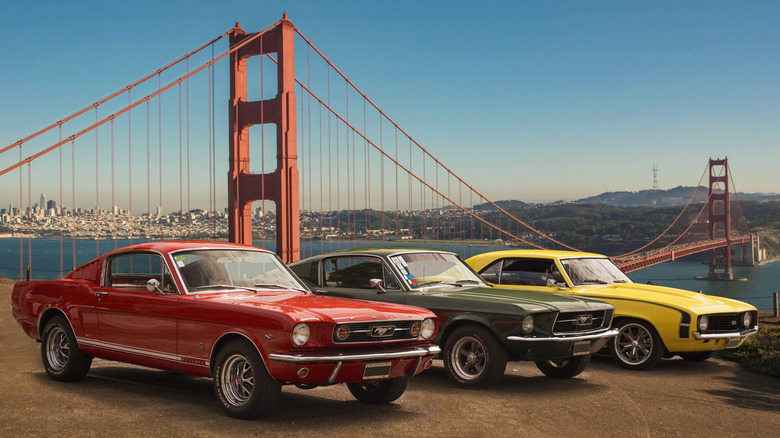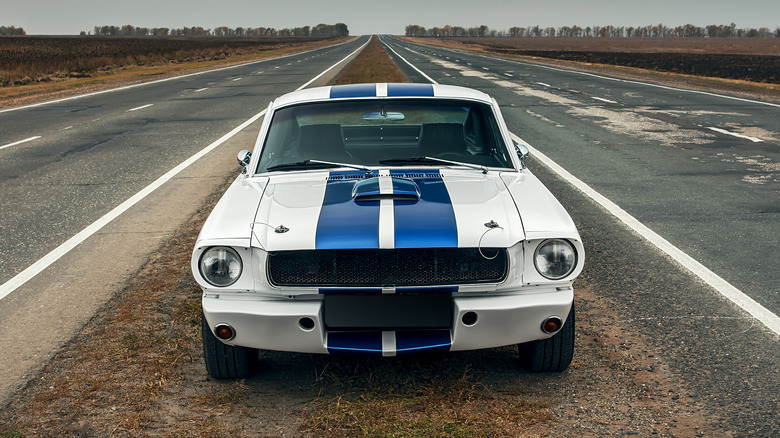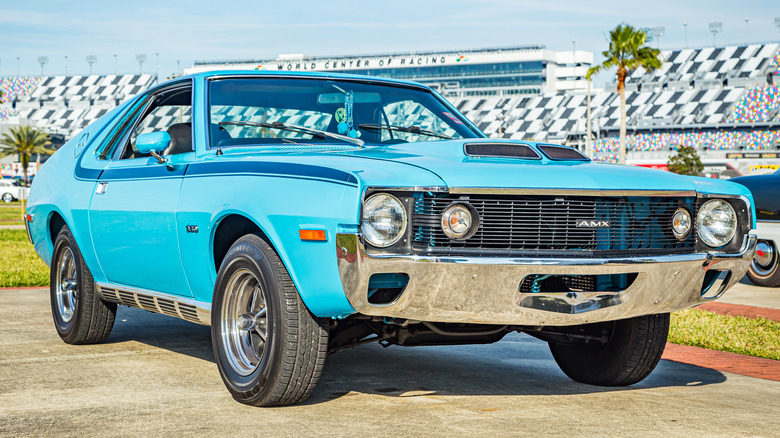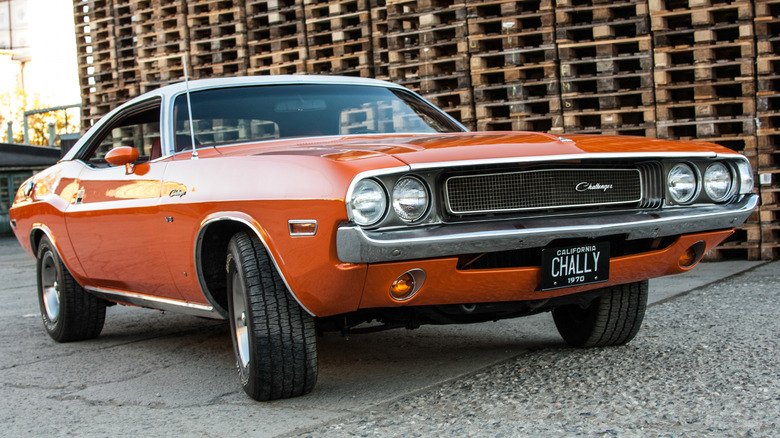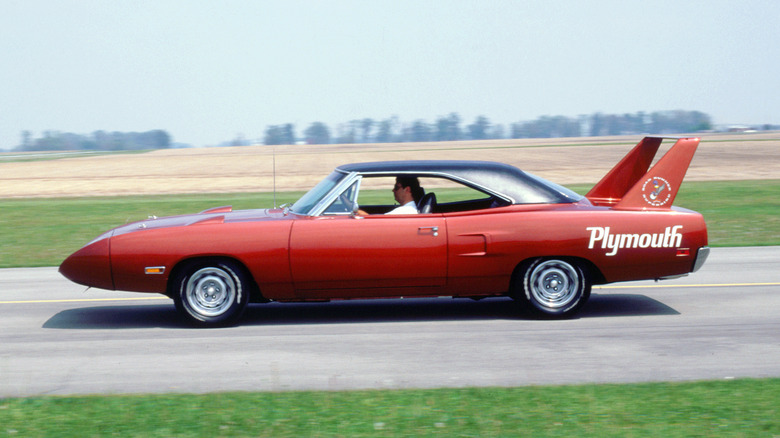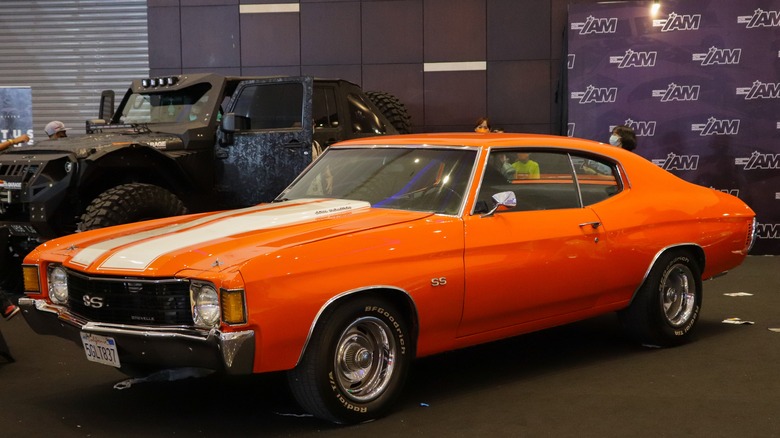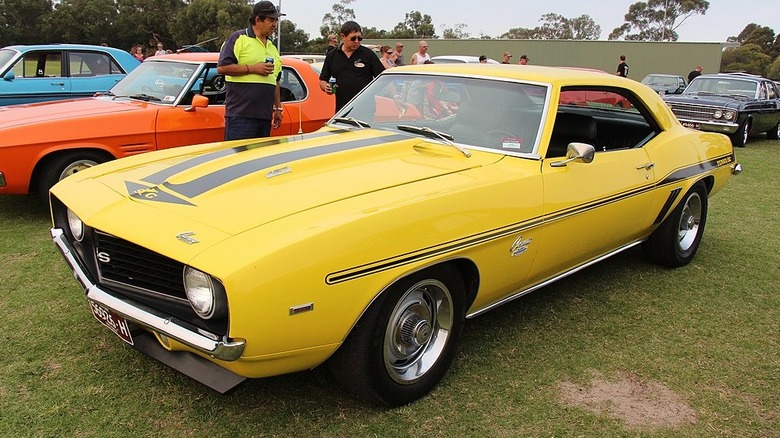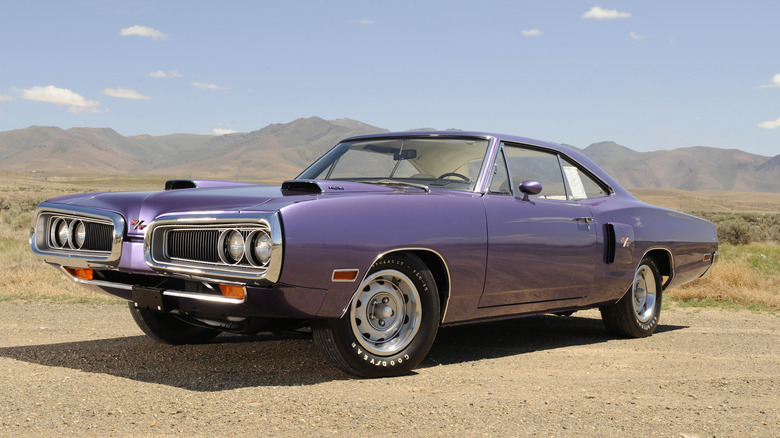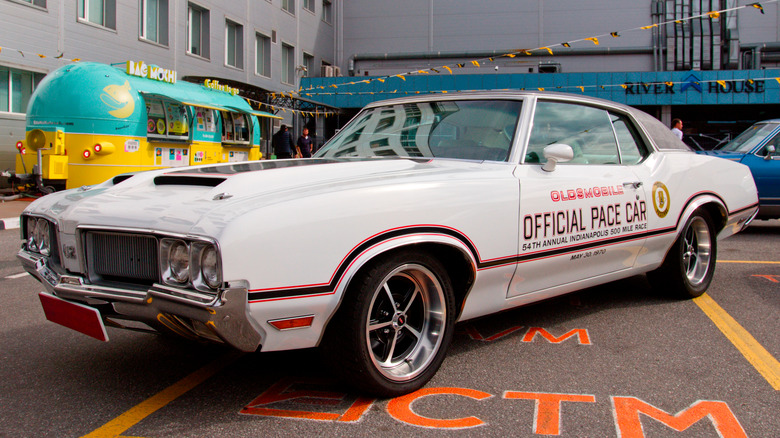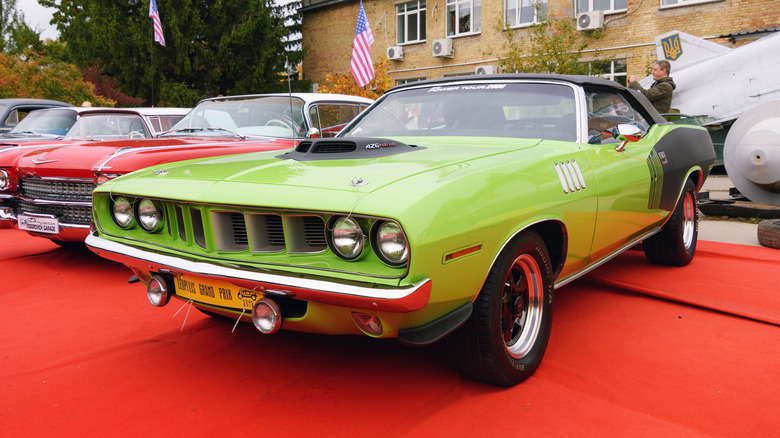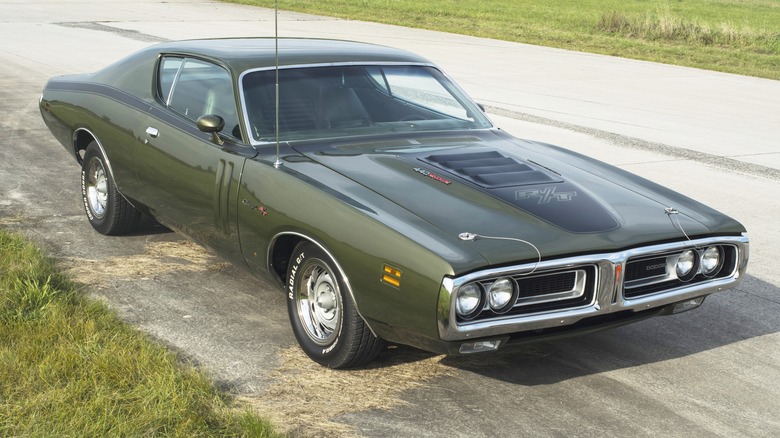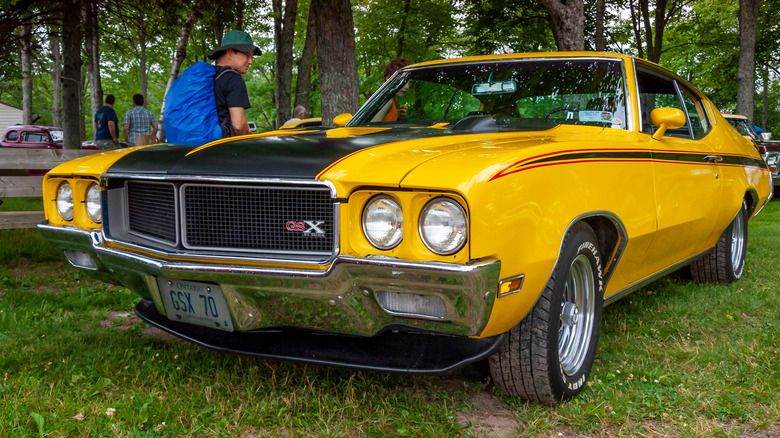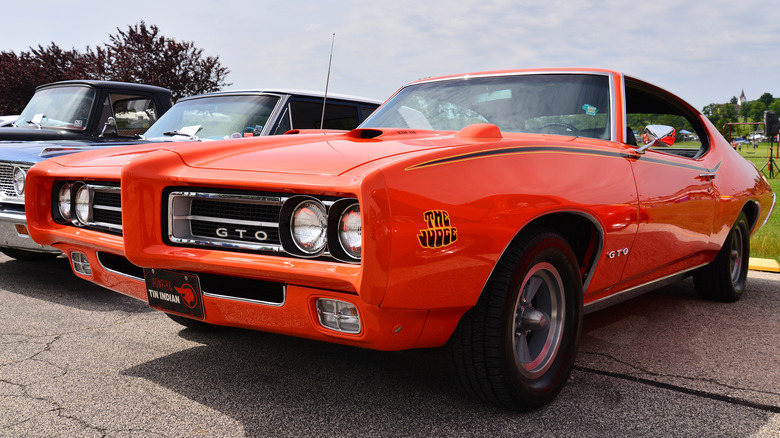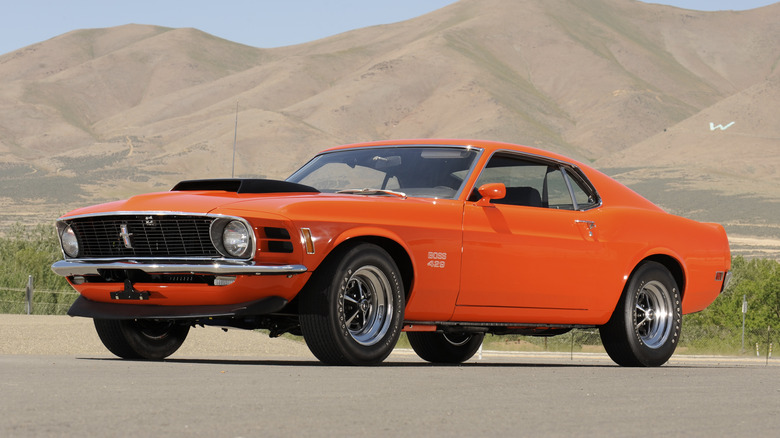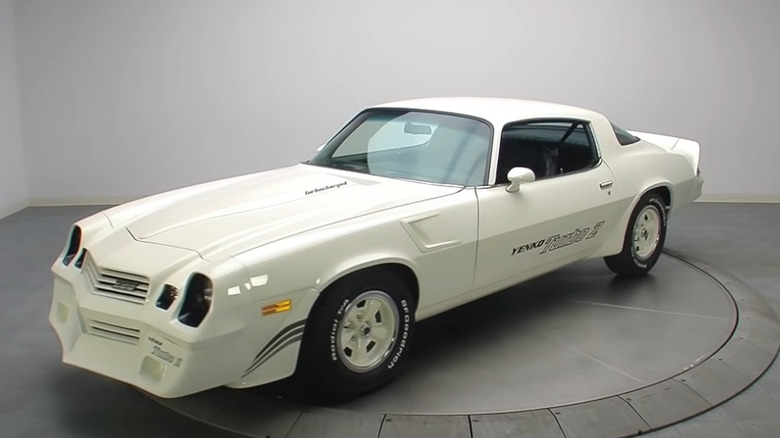14 Classic Muscle Cars That Are Actually Worth Owning Today
Muscle cars are as American as wide, open highways, fast-food drive-thrus, and apple pie. Born in the '60s at a time when American manufacturers were engaged in a race for the most horsepower, muscle cars showcased the most advanced engine technology automakers had to offer at the time. While there is some debate on what exactly defines what makes a muscle car, some agreed-upon traits include two doors, V8 engine, and lightweight chassis. They are generally a mid-size car and also carry four passengers. Most are a notchback design with a trunk, however, a few fastbacks are included. One trait they all share is horsepower — lots of it.
The heyday of the muscle cars was in the period of the late '60s and early '70s before a global oil crisis and regulations on safety and emissions started to spoil the fun. Horsepower ratings peaked in 1970 before big block engines fell out of favor and everything else became so restricted that even a Cadillac 500-cubic-inch engine barely made 200 horsepower. These are some of the most celebrated cars in the American auto industry, and they have seen a resurgence with new models coming out and classics shooting up in value. There are a lot of good muscle cars to choose from, and the most desirable models today can only be owned if you have a bit of wealth. But, should money cease to be a factor, these are 14 muscle cars that are actually worth owning today.
Mustang Shelby GT350
Carroll Shelby is a legend of American auto manufacturing and racing. He put together the car, the GT40, that helped Ford beat Ferrari at LeMans and cemented his position modifying cars for Ford Motor Company. In the first full year of production for the all-new Mustang, which was already breaking sales records, Shelby got a hold of a fastback version and created what would be the first of many ultra-fast Shelby-branded Mustangs, the Shelby GT350. According to CJ Pony Parts, this car was originally conceived as a machine for racing, and copies were built for the street and the track. Thirty-five Shelby GT350R models were made for racing purposes, and another 513 road-going copies were made and sold to the public.
GT350s came equipped with the Ford 289 V8 making 306 horsepower, which was 35 over stock form, and GT350R models were bumped to 360 horsepower, which propelled the car to be B-class champion for three years straight. The car got its name not from engine size or horsepower, but from the number of steps it took for Shelby to walk from his shop to the L.A. airport. Shelby thought the car itself was more important than its name. Ford revived the GT350 name for several high-performance variants through the 2010s, retiring the name again in 2021. With so few 1965 models made, it is among the most collectible cars in the world, with auctions resulting in a $4 million sale in 2022.
AMC AMX
American Motors Corporation was an independent automaker that struggled to survive for decades. However, despite its economic struggles, the plucky little company from Kenosha, WI managed to crank out interesting cars year after year. Having smaller budgets for development meant having to be clever and inventive to make new models from old designs, and to utilize parts across the whole model range. Designer Dick Teague may have been the company's greatest asset, as he was able to work with these confined conditions to create some remarkable designs for cars that are still desirable today, such as the AMX (via Heacock Classics).
Often obscured from the long shadows of Mustangs, Chargers, and Camaros of the day, the AMX was competent competition in this time of fast and garish muscle cars. In the end, AMX only lasted through three model years. Having only two seats and going up against competition with much deeper pockets made it hard to gain traction in the market, and 1970 was its final year. Today they are a favorite among collectors, and their rarity makes them a popular curiosity at classic car events. The good news for collectors is that their value remains substantially lower than other muscle cars of the era, and an extremely nice one can be had for under $50,000.
Dodge Challenger
Dodge came a little late to the pony car party. Plymouth had been running the Barracuda against Mustangs and Camaros for some time when Dodge released its Challenger in 1970. The first generation Challenger, according to The State Journal-Register, was only on sale for four years and its total production was rather low compared to the Ford and GM pony cars of the time; only 165,437 units were made. The oil crisis hit hard and killed fuel-thirsty muscle cars, especially the Hemi 440, 426, and 383. A Challenger of note from the time is the T/A Challenger, which was equipped with a 340 six-pack, meaning it had a trio of two-barrel carburetors.
While the Challenger was dropped in 1974, the name was revived when it was placed on an imported Mitsubishi Galant coupe with a 4-cylinder engine. It was much smaller and had half the cylinders. It was not a muscle car (via Classics Beyond). But, in 2005, Dodge brought back the Challenger not just as a V8 pony car, but with the same lines as the original in a modern package. It has been a huge success and spawned some of the fastest and baddest modern muscle cars there are, including the 840-horsepower Demon, an honorable successor to the original.
Plymouth Superbird
The 1970 Superbird was Plymouth's answer to the Dodge Charger Daytona that hit the tracks a year before. While the cars may look similar, they are not the same, however, Plymouth was able to use the wind tunnel test data that Dodge had used already. The single purpose of the Superbird was to win NASCAR races, and it did. When Dodge created the Daytona, 550 road-going copies had to be made, but, due to rule changes, Plymouth had to produce 1,900 copies of the car to be sold in dealerships. Creating and building this car was an expensive endeavor and would push the retail price up significantly over stick vehicles, but Plymouth made it anyway (via Volo Auto Museum).
Part of Plymouth's plan with the car was to encourage Richard Petty to return to the brand for racing, which he did. With the Superbird at Petty's control, it won eight races, with an additional 10 wins by other drivers. It was a success. NASCAR changed the rules once again in 1971, making the car obsolete. Therefore, only one year model exists and today it is strikingly rare and astronomically valuable. While the original selling price of the Superbird was $4,280, one sold recently at auction for a record $1.65 million at Barrett-Jackson.
Chevrolet Chevelle SS396
The muscle car era was flush with big block power from all the manufacturers, and Chevrolet was no exception. The Chevy 396 was the big block engine suitable for making large amounts of power while remaining tame enough to keep it on the street. It was a popular engine, especially when fitted in a Chevelle in the SS396 model, which debuted in 1965. These first-year SS models came with a 327-horsepower L37 396 V8, improved brakes, and a stiffer suspension. The option code for this car was Z16, and only 201 were built that year (via The Providence Journal).
The SS396 was a popular seller in the next years of sales, but it became an option for any car in the second-generation Chevelle rather than a specific model. Today the SS396 is among the most collectible Chevelles made and one of the most collectible Chevrolets from the period, especially convertibles as few were produced. Sotheby's listed one in 2008 with a winning bid of $74,250. It is likely that value would double today. However, should one be found run down in a barn somewhere, parts are easily obtainable and an old wreck can easily be turned into gas-powered gold.
Chevrolet Camaro ZL1
Using GM's special order system, a clever dealer in Illinois special ordered a Camaro with the built-for-racing ZL1 427 V8 for inventory, resulting in a total of 69 being produced. At the time, the ZL1-code engine was a big block 427 V8 that was all-aluminum construction for race cars, whereas consumer engines were iron and weighed 100 pounds more. Official output of the engine was 430 horsepower but, according to MotorTrend, actual output was likely north of 500. Some hand-wringing was involved in getting the cars from Chevrolet, as project managers did not want to build the cars, and set a minimum order of 50 units. Chevy dealer Fred Gibb agreed to the order of 50 cars and they headed into production. Thirty-seven would eventually be returned to Chevrolet, and those were subsequently sent back out to other interested dealers.
These performance-oriented models originally sold for around $7,000, which was a higher price than the new Corvette at the time. But things have changed since then. High-performance vehicles tend to hold value well and special editions can fetch high prices as the cars age. The ZL1 fits in line with this, as surviving models are possibly the most valuable Camaros in existence. One model in mint condition crossed the auction block at Barrett-Jackson in 2019, selling for just shy of $1.1 million, per GM Authority. The legacy of the ZL1 lives on today as Chevrolet revived the option package with the current model, offering a supercharged V8 that makes 650 horsepower.
[Featured image by via Sicnag Wikimedia Commons | Cropped and scaled | CC BY 2.0]
Dodge Coronet R/T
In 1965, Dodge reduced the size of its full-size cars in response to market trends. That decision, according to Hemmings, was a bit foolhardy as other manufacturers did not follow suit, and that left Dodge's cars looking small by comparison. The new, smaller car was then introduced as an "intermediate" size and used a revived name from the '50s: Coronet. It turned out to be a good idea as it ended up being a favorite model from the muscle car era.
While the Coronet was smaller than the large family cars of the time, it put it at a great size for competing with other muscle cars, such as the Pontiac GTO or Ford Torino. It would be small enough to deliver decent handling but remain stout enough to shove a giant Hemi engine under the hood, and that is what Dodge did. The star of the Coronet line is the Coronet R/T model. This received, as standard, the 440 Magnum engine with three-speed TorqueFlite transmission standard with a Hemi engine and four-speed gearbox optional. The R/T received a tachometer, bucket seats, bigger brakes, and upgraded suspension, and later-year models could get raised hood scoops. The torque from these massive engines makes the car pull off the line from the start (via How Stuff Works).
Oldsmobile 4-4-2
Pontiac's GTO set off a storm in the auto industry that had product planners scrambling for a way to compete with their own performance model. Oldsmobile responded by applying its B09 "Police Apprehender-Pursuit" package to the existing Cutlass line, calling it a 4-4-2 for its four-barrel carburetor, four-speed transmission, and dual exhaust. The initial model featured a 330 V8 with 310 horsepower. Once Oldsmobile had some time to properly develop the model, it received a new 400-cubic-inch V8 based on the 425 big block, which changed the naming convention to 400, four-speed, and dual exhaust (via Hemmings).
Oldsmobile kept the 4-4-2 name up through the '90s, although the cars lost the meaning behind the numbers long before. The first two generations are the greatest of these models, as everything after 1973 lost a lot of horsepower. The last model was a Cutlass Calais Quad 442, with a 4 or 6-cylinder engine turning the front wheels and a max of 190 horsepower (via Volo Auto Sales). It kind of signaled the death of the muscle car. The first generation 4-4-2 models are excellent collector cars that embody '60s American muscle well, and can be found at auctions in excellent condition today for $20,000-$40,000, according to Classic.com.
Plymouth Hemi 'Cuda Convertible
The Plymouth 'Cuda is an offshoot from its popular Barracuda line, but maintains its own separate name. For 1971, the 'Cuda came equipped with the 426 Hemi engine backed up by a heavy-duty version of the 727 TorqueFlite transmission or a four-speed manual. It was also treated to suspension upgrades and chassis reinforcements, but disc brakes were an option. The giant engine made for substantial torque and propelled the car to 60 mph in just 5.8 seconds, however, it could also handle a few corners, something challenging for other muscle cars of the day. 'Cudas also received aesthetic treatments including special paint, graphics, and decorative air slots above the front wheel wells (via Gear Patrol). To be blunt, they are beautiful cars.
The 'Cuda showed up just as the party was winding down. It would be just a couple of years before the creation of the EPA and the days of big, dirty power were numbered. But if, as a car company, you wanted to end the muscle car era on a high note, then Plymouth succeeded brilliantly. This second generation of Barracuda was a rousing success for Chrysler, selling tens of thousands of units over its four-year run. However, Hemi 'Cuda sales were much more limited as the company's high-performance packages made them significantly more expensive. Therefore, only 652 Hemi 'Cudas coupes were built with an additional 14 drop-tops. As a result, in 2021, according to Fox News, one of the convertibles went up for auction with Mecum and failed to meet the reserve with a bid of $4.8 million.
Dodge Charger R/T Hemi
Dodge released the first Charger in 1966 as its first fastback intermediate racer. While the Coronet filled out the intermediate-size cars, fastbacks were all the rage, and Dodge wanted to cash in on the popularity, so it created the Charger as a fun and fast alternative. The first-generation models can be identified by their distinctive rectangular inset from grills with hidden headlights and the long sloping rear window that terminates near the end of the trunk. It also features rear windows, a rarity for two-door cars, and lacks a pillar, creating an open and spacious cabin that can feel almost like a convertible when cruising down the highway.
Dodge redesigned the Charger for 1968, making several styling changes that introduced more curves and special editions, notably, the Charger R/T, a member of what Chrysler marketed as "The Scat Pack," also including the Coronet R/T and Dart GTS. The automaker performed another redesign just a couple of years later with the 1971 model. The R/T package held over, although sales fell sharply. For the 1971 year model, only 63 Charger R/T models left the factory. This was and is the most desirable model of Charger that Dodge ever made. Current prices get close to $320,000, especially if equipped with the ultra-rare sunroof option, according to Classic.com.
Buick GSX
In the pantheon of American muscle cars, names like GTO, Chevelle, and Charger get tossed around a lot, but an oft-overlooked nameplate that also deserves recognition is Buick's GSX. Based on the popular Skylark model, the GSX was sold as a stand-alone model to showcase Buick's more aggressive performance abilities. The 1970-1972 Buick GSX came in a variety of bright, eye-catching colors and with a monstrous 455-cubic-inch V8 engine. Buick wanted to attract younger buyers to the brand and felt the more muted colors and conservative styling in its lineup was not cutting it. The GSX broke the mold in a bold way, rather successfully (via Muscle Car Illustrated).
While the GSX did successfully bring out the flair and attitude of a younger and more aggressive buyer, it did little to boost sales. Buick moved 678 units of the GSX in 1970, while the Pontiac GTO Judge passed 3,000 units, and GTO nearly hit 4,000. Owning a classic muscle car like this brings some unique advantages over more well-known examples. Pristine examples of a GSX will be expensive, but not overvalued like some of the auction stars from the period. But perhaps the most gratifying benefit is that, at a classic car show, a Buick GSX will draw a lot of attention from curious enthusiasts who may not be familiar with it, leaving ample opportunity to talk about it with like-minded fans. Current listings from Hemmings show that perfect condition examples can be had for about $50,000.
Pontiac GTO The Judge
John DeLorean is often said to have kicked off the muscle car era with his Pontiac GTO performance model of the LeMans. It proved to be a wildly successful project and the model remained a part of the Pontiac lineup until 1974. DeLorean later wanted to release a model that appealed to younger buyers with performance in mind. His car ended up featuring a 400-cubic-inch V8 with a Ram Air induction hood, Hurst shifter, functional rear spoiler, wider tires, and custom decals denoting the special model. According to Silodrome, he was a fan of Sammy Davis Jr. on the popular comedy show "Rowan and Martin's Laugh-In" and he called it The Judge, a reference to the "Here comes the judge" skit. It was bright and brash, and originally came in only one color, orange, which was officially called Carousel Red.
While the initial idea was to make a more affordable performance package for the GTO, The Judge's price was higher by a fairly large amount. The Judge performed well in terms of sales, with nearly 10% of GTO production coming with the special package. As much of a shot in the arm The Judge provided for Pontiac, the writing was on the wall for muscle cars, and 1969 would be the only year it made it to dealers (via Audrain Automotive Museum). The unique package offerings and graphics package make it a highly desirable car to own. Recent sales on Bring a Trailer show that you will need up to $100,000 to get one yourself.
Ford Boss 429 Mustang
Modern Mustangs offer a range of options for those who want huge horsepower numbers that include supercharged and turbocharged engines with direct injection and complex digital controls. In 1969, the only option for gaining horsepower was to gain displacement. And that is why the 1969-1970 Boss 429 is king of classic Mustangs. The Boss 429 was part of Ford's desire to make faster cars to win on the track. It enlisted the builder of the company's successful GT40 LeMans winner to stuff the biggest engine possible into the popular pony car.
The Boss 429 was manufactured for only two years, with just enough models made to satisfy homologation rules for NASCAR. This means a scant 1,359 left the workshop in total. The car was officially rated at 375 horsepower with many contemporaries claiming actual output was much higher. Regardless, it made for a fast pony car that won its fair share of races and went on to be among the most valuable of all Mustangs. As fast cars go, you can't do much better than the Boss 429. As long-term investments go, it may not be too bad, either. Paying the original sticker price of about $4,000 now yields a sum of nearly half a million dollars when these are brought up for auction today, according to the Lincoln Journal Star.
Chevrolet Camaro Yenko Turbo Z
While the most popular and highly praised muscle cars come from the late '60s, muscle cars did not completely die with the creation of the EPA. Furthermore, auto manufacturers placed many resources into making modified cars to sell performance variants to the public for increased revenue and marketing purposes, while some smart dealers created their own versions independently of the manufacturers.
One Chevrolet dealer, Don Yenko, began modifying Corvairs and Camaros. With backing from Chevrolet, he produced several versions of these cars that have become coveted collector items today. The last of these projects was the 1981 Turbo Z Camaro. By 1981, horsepower ratings had fallen precipitously along with emissions. Yenko found a good way to bring the horsepower back up by adding a turbocharger to the Camaro. The Z/28 Camaro came with a 350 small block V8 with Yenko adding a turbo providing up to 7 pounds of boost. It also had water injection and a fuel heater to keep it compliant with EPA rules. No horsepower stats were published, but Hagerty estimates a range of 240-250 based on its quarter-mile run time of 14.51 seconds.
While it was past the prime of the muscle car era and its power output still paled in comparison, it is a unique and clever car. Working within the technological constraints of the day, Yenko managed to squeeze a good increase of power out of the car and create something special. Only 19 were built, which makes it extremely rare today.
